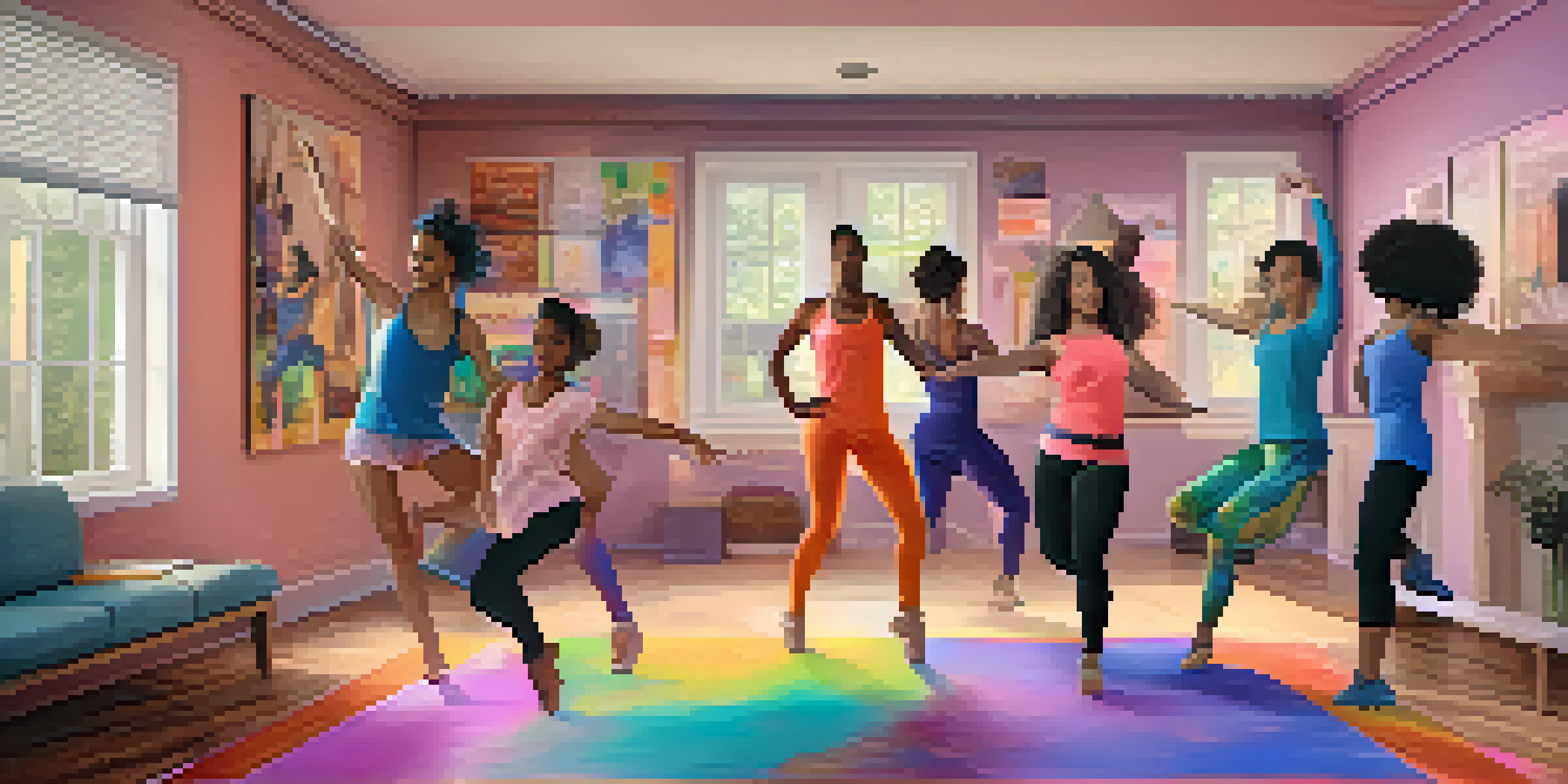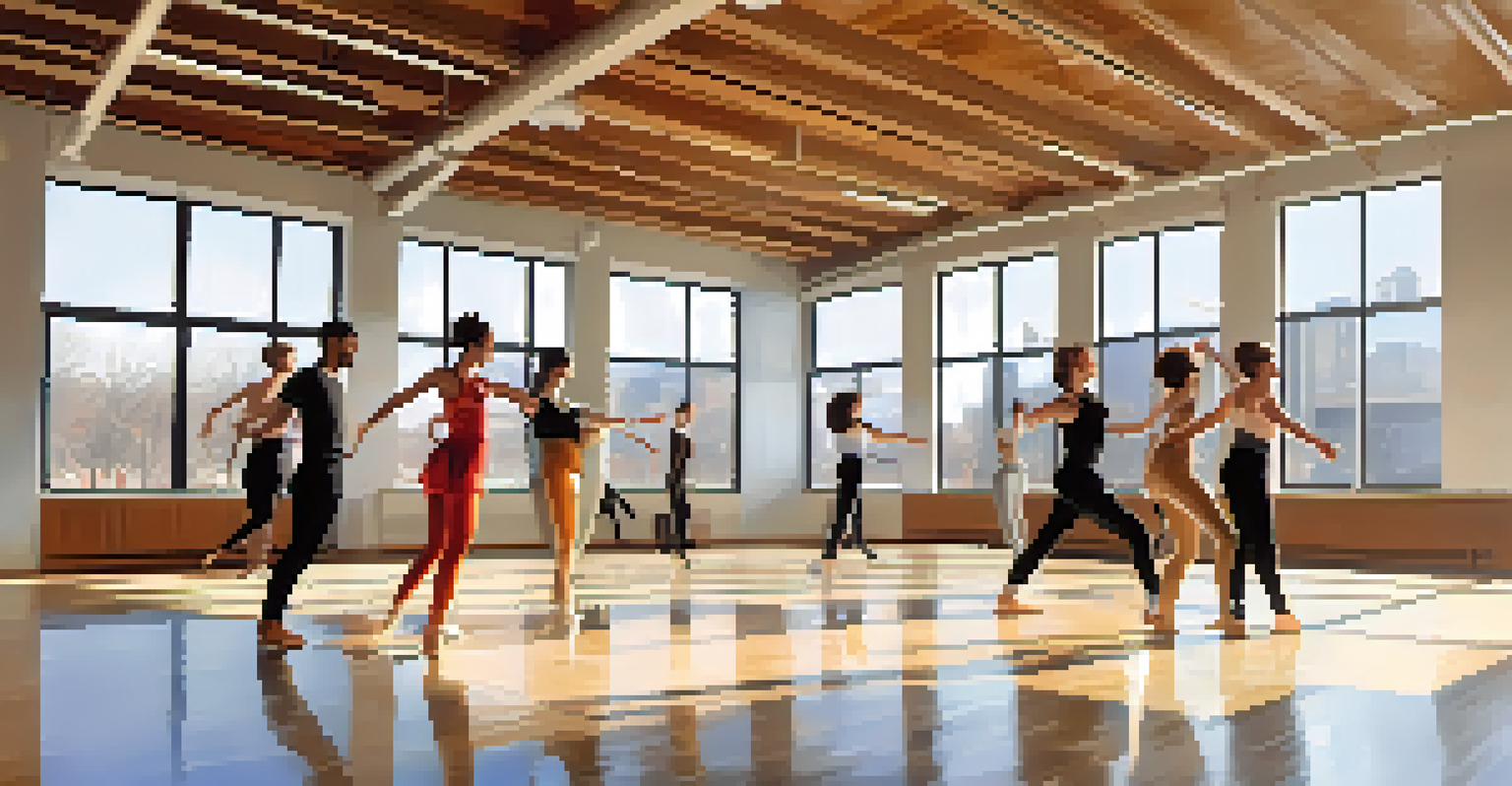Digital Collaboration: How Dancers Connect Across the Globe

The Rise of Digital Platforms in Dance Communities
In recent years, digital platforms have transformed the dance landscape. Social media, video conferencing, and collaborative apps have made it easier than ever for dancers to connect. This shift has allowed dancers from diverse backgrounds to share their art and learn from one another, regardless of geographic boundaries.
Dance is the hidden language of the soul.
For instance, platforms like Instagram and TikTok have become powerful tools for dancers to showcase their talent and trends. Dancers can instantly upload their performances, reaching an audience worldwide. This instant feedback loop encourages creativity and allows for the rapid exchange of ideas, making dance a more inclusive art form.
Moreover, digital platforms provide opportunities for collaboration that were previously unimaginable. Dancers can now participate in virtual workshops, choreographic challenges, and online dance classes, creating a vibrant community that transcends borders and fosters mutual growth.
Virtual Classes: Learning Without Limits
Virtual dance classes have revolutionized the way dancers learn and grow. No longer confined to local studios, aspiring dancers can now attend classes taught by renowned instructors from around the world. This access to diverse teaching styles enriches the learning experience and broadens dancers' perspectives.

For example, a dancer in a small town can take a ballet class with a New York City professional, gaining insights that would have been difficult to acquire otherwise. The flexibility of online classes also means that dancers can choose to learn at their own pace, fitting their passion into busy schedules.
Digital Platforms Transform Dance
Digital platforms have revolutionized how dancers connect, learn, and collaborate across the globe.
Additionally, these online classes often include interactive elements, like real-time feedback and Q&A sessions. This engagement helps create a sense of community, encouraging dancers to connect with peers and mentors, fostering relationships that can last a lifetime.
Global Choreography Collaborations
Choreographers are now able to collaborate seamlessly with dancers across the globe. Utilizing video conferencing tools, they can create and share choreography in real time, regardless of their physical locations. This new way of working has led to innovative and exciting dance pieces that blend various styles and cultural influences.
Technology is best when it brings people together.
For instance, a choreographer based in London can work with dancers in Tokyo to fuse contemporary and traditional dance styles. This cross-cultural collaboration not only enriches the art form but also promotes understanding and appreciation of different cultures.
Moreover, the documentation of these collaborative efforts through video allows audiences to witness the creative process. It breaks down barriers and showcases the beauty of collaboration, inspiring others to explore their own creative connections across borders.
Social Media: Showcasing Talent and Building Community
Social media plays a pivotal role in connecting dancers and showcasing their talent. Dancers can share their performances, behind-the-scenes moments, and even their training routines, creating a personal connection with their audience. This visibility fosters a sense of community among dancers and fans alike.
Platforms like YouTube and Instagram allow dancers to build their brands and gain recognition. As they share their work, they can attract followers who resonate with their style, leading to potential opportunities for collaboration and performance. This democratization of exposure has made it possible for even the most talented dancers to find their audience.
Virtual Classes Expand Learning
Online dance classes provide access to diverse instructors, allowing dancers to learn at their own pace.
Additionally, social media often serves as a platform for discussions around dance, from technique tips to industry trends. Dancers can engage in meaningful conversations, share resources, and support one another, creating a global network that thrives on collaboration and shared passion.
The Impact of Online Competitions
Online dance competitions have gained popularity, allowing dancers to showcase their skills on a global stage. These competitions often provide a platform for dancers to submit their performances digitally, making it easier for judges and audiences to access their work. This flexibility has opened doors for many talented dancers who may not have been able to participate in traditional competitions.
For instance, a dancer from a rural area can compete against others from major cities, leveling the playing field. This exposure not only boosts confidence but also provides valuable feedback from experienced judges, helping dancers improve their craft.
Furthermore, the sense of community fostered by these competitions encourages networking among dancers. Participants can connect with one another, share experiences, and even collaborate on future projects, reinforcing the idea that dance is a universal language that brings people together.
The Role of Technology in Dance Creation
Technology has significantly influenced dance creation, allowing for innovative choreography and performances. Dancers now utilize tools like motion capture, animation, and augmented reality to push the boundaries of what is possible on stage. This integration of technology not only enhances the visual experience but also opens up new avenues for creativity.
For example, choreographers can use software to visualize their pieces before they are performed, experimenting with different movements and formations. This ability to simulate and refine ideas has led to more polished and imaginative performances that captivate audiences.
Global Community Through Dance
The digital age has fostered a vibrant global dance community that celebrates diversity and creativity.
Moreover, technology enables dancers to document their work in unique ways. High-quality video editing and production techniques allow them to create stunning visual pieces that can be shared globally, further expanding their reach and impact in the dance community.
Building a Global Dance Community
The digital age has fostered the development of a vibrant global dance community. Dancers from various cultures and backgrounds can connect, collaborate, and celebrate their art together. This sense of belonging encourages dancers to share their unique stories and styles, enriching the dance landscape as a whole.
Online forums, social media groups, and virtual events provide platforms for dancers to share their experiences and learn from each other. This exchange of ideas fosters creativity and innovation, allowing the art form to evolve continuously.

As this global community grows, it becomes essential to embrace diversity and inclusivity. Supporting one another and celebrating different styles and backgrounds not only enhances the dance world but also promotes understanding and respect among dancers everywhere.